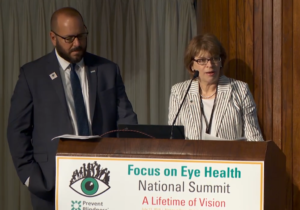Our mission is to prevent blindness and preserve sight.
Our History
1908
1917

Successfully led legislation that virtually eliminated a leading cause of blindness in infants, called ophthalmia neonatorum.
1926
1942
1944
1956
1972
1985
1995
1996
2002
2003
2006

The first annual Eyes on Capitol Hill campaign brought more than 100 patients and vision advocates to Washington, D.C. to discuss eye health policies with legislators.
2009
2014
2018
Today

The annual Focus on Eye Health National Summit has become a key venue to elevate the national dialogue around vision and significant public health issues such as surveillance, access, prevention messaging, service integration, and program development and replication. It’s also been a strong springboard to release important new public health information, including prevalence and forecasting data and discuss a range of population health advocacy issues and research opportunities relating to eyes and vision.


